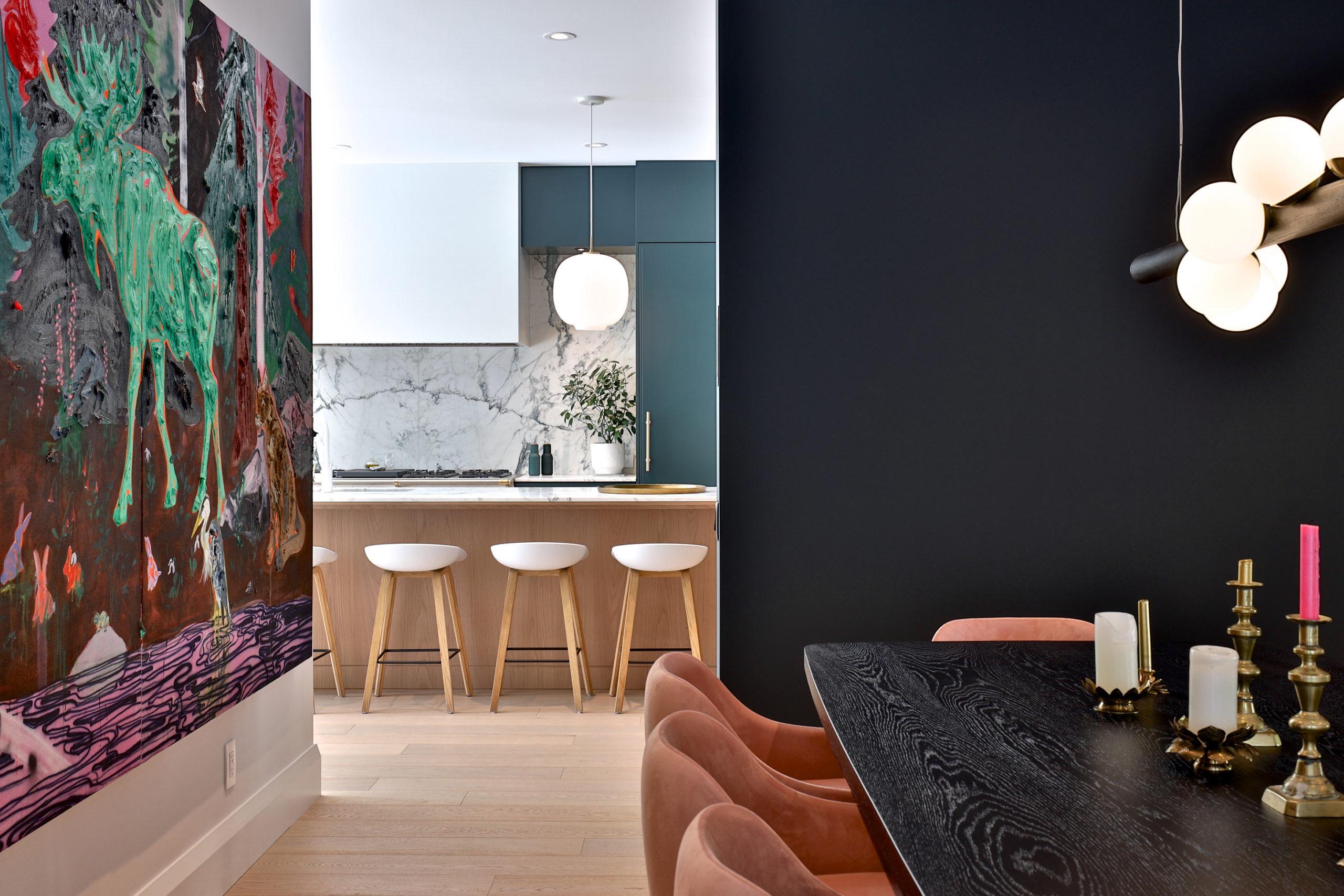
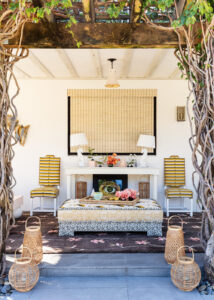
Many home owners are looking to prioritize wellness by establishing dedicated spaces such as an outdoor yoga area..
THREE INTERIOR DESIGNERS SHARE THE NEW DIRECTION HOME DESIGN IS TAKING AND HOW THESE KEY INGREDIENTS CAN HELP YOU TURN YOUR HOUSE INTO THE HOME YOU’VE ALWAYS WANTED
As with fashion, home trends come and go faster now than ever before (good-bye, glass tile), making it important to take a more thoughtful and sustainable approach. “There will always be people who want the trends, particularly first-time home-buyers. But I think those who have renovated before don’t want a trend,” says interior designer Colette Volk, from Colette Volk Design. “They want their own look—something new and personal that speaks to them.”
With that in mind, we asked Toronto design experts for some guiding principles for when it’s time to give your home an update. From better-utilizing space to prioritizing sustainable materials—and having fun with colour along the way—there are lots of inspirational ideas to take home.
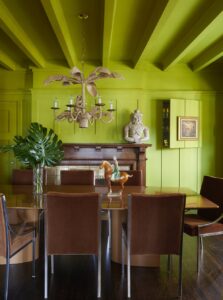
The pandemic made us focus more on what we need to function best in the space that we have.
IMPROVE LIVABILITY
As we’ve come to live, work, entertain and exercise in our homes during the past few years, homeowners have realized they have spaces that are underutilized. Interior designer Gillian Gillies, from Gillian Gillies Interiors,
is pleased to see people now configuring their homes for themselves—and not just for the occasional guest. “The pandemic made us focus more on what we need to function best in the space we have, as opposed to having a massive dining room that doesn’t get used or a guest bedroom and bathroom that’s occupied only a few times a year,” she says.
Interior designer Colette van den Thillart, from CVDT Interior Design, agrees. “I’m a firm believer in the psychology of how the home is a factor in the quality of our life, a major player in our wellness,” she says. To achieve this, van den Thillart explains, designers are now looking at approaches that take mental health and happiness into consideration. When she first starts to work with a family, van den Thillart gets to know them, gauging their likes and dislikes, taking a psychological read on the whole family dynamic, before creating something that’s not only functionally supportive to how they live, but aesthetically pleasing.
Gillies also finds that many of her clients now realize how much sound is transmitted through their homes, having noticed that when everybody’s there, a house can be noisy. “We’re putting in acoustic panels and designing spaces so that the kids can be home playing computer games or watching TV, but not everybody in the house has to take part.”
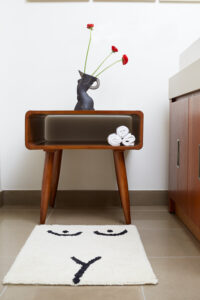 MINIMIZE SYNTHETICS
MINIMIZE SYNTHETICS
“Natural materials are huge,” says Volk. She has recently been travelling to the United States and Mexico, sourcing handmade materials to incorporate into her work, including hand-woven fabrics, baskets and carpets, things that add instant texture to a room. “I’m looking out for the beautiful and the unexpected items that you can’t find in the stores here.”
More vendors and suppliers are doing the research, developing new natural products and bringing them to the table, according
to van den Thillart. She adds that textile, hardwood and paint suppliers are considering how to make products safer for the home. “We try to use as many natural materials as possible,” she says. “Certain things like carpet have a bad rap for off-gassing, so I tend to stick to wool and abaca fibre and natural-fibre carpets.”
“I think the pendulum swung to a point where everybody wanted fabric that was stain-proof,” Gillies says, adding that stain- and soil-resistant fabrics often don’t feel very nice. The return to natural fibres “relates back to wellness and to designing for you and for how you want to live,” she says. “Having a 100 percent wool carpet that’s incredibly durable and can be cleaned is better than having a rug that may be toxic.”

Using texture, patterns and colours like mustard and pink help to create a fresh new take on traditional styles.
GIVE TRADITION AN UPDATE
Volk is seeing a total return to traditional décor, but interpreted as a “fresh, young traditionalism,” updated with more warmth and colour to avoid any hint of stuffiness. She has been taking English- and European- style homes and refreshing them by using unexpected colours such as different shades of pinks and burgundies, bright greens and blues together, or mustards and teals. She
is also redoing traditional patterns in newer palettes with decorative trims in contrasting colours. “My clients typically tend to not want the same thing everybody else wants,” she says. “They’ve had the more contemporary houses and the neutral palettes, and now they want a conventional yet still playful feel.”
The use of porcelain is an easy way to inject pattern and colour into foyer floors, bathroom walls and kitchen counters, Volk adds. “Certainly in the kitchen, people don’t want monochromatic anymore.” Another benefit to porcelain is its affordability. “There are so many beautiful porcelains out there now, you can have the same beautiful floors you would find in a traditional manor home at a fraction of the cost of marble, which is so expensive,” Volk says. “We’re doing things for $10 or $20 a square foot.”
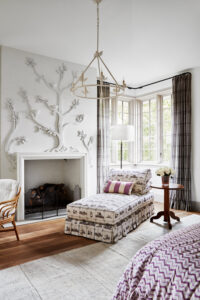 CREATE AN AT-HOME WELLNESS CENTRE
CREATE AN AT-HOME WELLNESS CENTRE
Gone are the days of just having a plain old bathroom. “Instead of going to the gym or
the yoga studio, people are putting wellness centres in their home,” Gillies says. This means not just a steam shower but perhaps also an infrared sauna, a plunge pool or a shower with body-massaging jets. “And within that, we’re incorporating sound, colour and smell, which helps balance all the senses,” Gillies says. “People really want to take care
of themselves, and they want to feel that their home is the place for that, rather than going somewhere else.”
If you already have a gym at home, van den Thillart says, you may also want it to now function as a meditation room or a yoga studio, too. Within smaller homes, it may be a case of just setting up furniture so that there’s a corner dedicated to wellness, “where things can be moved around, so people can bring exercise into their lives without it being secondary to everything else,” she says. “If your gear is not right there, you tend to not use it.”
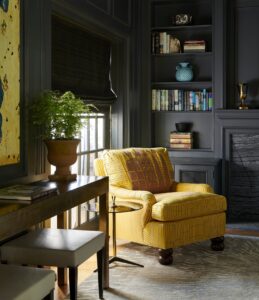 MAKE STYLE SUSTAINABLE
MAKE STYLE SUSTAINABLE
In the process of wanting to be environmentally friendly, homeowners are asking more questions about where their furnishings are coming from, looking for things that tell a story. “We’re incorporating a lot more craft pieces into our design schemes, and people are also more interested in buying locally,” Gillies says. “And when we can’t buy locally, they really want to understand the story behind the piece.”
Utilizing existing pieces—vintage or antique items—is a great way to bring sustainability into the home, van den Thillart says, often presenting better quality for better value. “And when I say antiques, that can mean Mid-Century Modern furniture, cool vintage ’80s pieces, edgy stainless-steel stuff— the whole gamut. This also brings character into the space, sustainability is just a lucky by-product.”
Images by: CVDT Interior Design/Alex Lukey, CVDT Interior Design/Virgina Macdonald; Nickolas Sargent, CVDT Interior Design/Alex Lukey; Melanie Acevedo; Laura Resen.
Words by Doug Wallace
